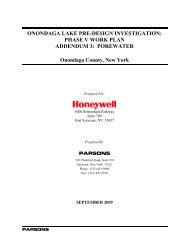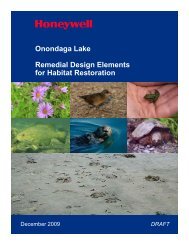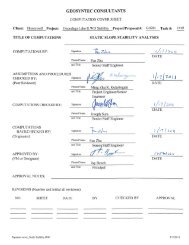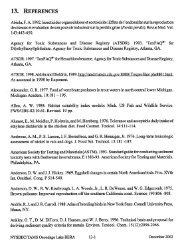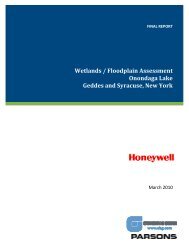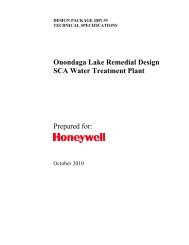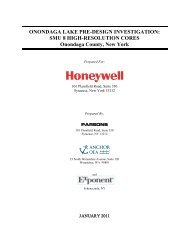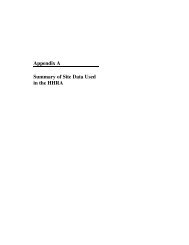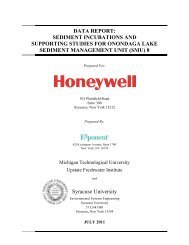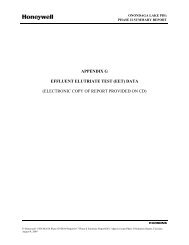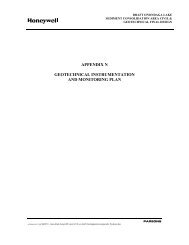Phase 1B Underwater Archaeological Report for the Onondaga ...
Phase 1B Underwater Archaeological Report for the Onondaga ...
Phase 1B Underwater Archaeological Report for the Onondaga ...
Create successful ePaper yourself
Turn your PDF publications into a flip-book with our unique Google optimized e-Paper software.
FINAL<br />
<strong>Phase</strong> IB <strong>Underwater</strong> <strong>Archaeological</strong> Resources <strong>Report</strong> <strong>for</strong> <strong>Onondaga</strong> Lake Superfund Site<br />
Anomaly 1/2: Salina Pier<br />
Anomaly 1/2 Summary Table<br />
Anomaly Identification Salina Pier; NY Site Number 06740.012292<br />
Remedial Impact<br />
Dredge and Cap<br />
NRHP Eligibility<br />
Eligible as a Contributing Property to <strong>the</strong> Syracuse Maritime Historic District<br />
Recommendation<br />
Anomaly Dataset<br />
Side Scan (2005) 0345, 0346<br />
Magnetometer (2005) 1013<br />
Side Scan (2010) 6/3/10<br />
Sector Scan (2010) 6/4/10<br />
ROV Video Footage (2010) 6/9/10<br />
Diver Observations No<br />
Diver Videography<br />
No<br />
Maps/Charts<br />
Yes<br />
Aerial Imagery<br />
Yes<br />
Historic Accounts<br />
Yes<br />
Salina Pier Historic Context 127<br />
The Salina Pier was initially constructed in <strong>the</strong> 1870s or 1880 at <strong>the</strong> mouth of Bear Trap Creek (now<br />
known as Ley Creek). 128 In 1881, <strong>the</strong> Central City Street Railroad Company built a hotel and car depot on<br />
<strong>the</strong> banks of <strong>the</strong> lake on <strong>the</strong> Salina side. The structures were constructed approximately 100 feet (30m)<br />
west of <strong>the</strong> present railroad terminus. The hotel was two stories high. 129 These structures may not be<br />
present on any of <strong>the</strong> historic maps, as it is noted that in <strong>the</strong> beginning of 1890, a windstorm destroyed<br />
Salina Pier and a saloon house at <strong>the</strong> end of it. 130 The pier is identified on <strong>the</strong> 1889 Sweet map. It was<br />
noted in <strong>the</strong> summer of 1890 that <strong>the</strong> water table was still high and that none of <strong>the</strong> pier was visible,<br />
suggesting that <strong>the</strong> pier was not being used <strong>for</strong> a lengthy portion of that year. In an attempt to compete<br />
with <strong>the</strong> Iron Pier resort, <strong>the</strong> Salina Pier company constructed a two-story pavilion, which also contained<br />
a concert hall and dining room, in 1890 south of <strong>the</strong> existing pier and north of <strong>the</strong> Iron Pier resort. By<br />
<strong>the</strong> late 1890s, <strong>the</strong> Salina Pier resort had closed, probably due to <strong>the</strong> greater number of attractions at<br />
<strong>the</strong> Iron Pier. In 1899, <strong>the</strong> Iron Pier resort purchased <strong>the</strong> land of <strong>the</strong> Salina Pier pavilion and had Solvay<br />
soda ash refuse placed up to 4 feet (1.22m) in depth to build up <strong>the</strong> land in front of <strong>the</strong> Iron Pier. 131 The<br />
pier remained intact through 1898 and served boats that ran regularly to all lakeside resorts. 132 Because<br />
of <strong>the</strong> construction of a trolley line on <strong>the</strong> west side of <strong>the</strong> lake in 1899, and <strong>the</strong> earlier construction of<br />
railroads on <strong>the</strong> east and west sides of <strong>the</strong> lake, Salina Pier may have fallen out of use by <strong>the</strong> early<br />
twentieth century. By 1908, <strong>the</strong> Salina Pier was replaced by “Breakwater,” which may have been some<br />
sort of barrier created <strong>for</strong> <strong>the</strong> Iron Pier or <strong>for</strong> navigation purposes on <strong>the</strong> lake. 133 By 1924, <strong>the</strong><br />
Breakwater was abandoned and flooded over by <strong>the</strong> raising of <strong>the</strong> lake <strong>for</strong> <strong>the</strong> Barge Canal.<br />
Research Results<br />
Anomalies A1 and A2 are parts of <strong>the</strong> remnants of <strong>the</strong> Salina Pier. The pier lies immediately north of A3,<br />
a barge wreck. The pier’s location was known from historic accounts and charts, aerial images, and was<br />
located during CRE’s 2005 remote sensing survey (Figure 38, Figure 39, and Figure 40). In <strong>the</strong><br />
<strong>Underwater</strong> Work Plan two separate anomalies were identified <strong>for</strong> <strong>the</strong> pier location, but <strong>the</strong> fieldwork<br />
showed that <strong>the</strong>y were separate parts of <strong>the</strong> larger pier structure. Salina Pier was a difficult site <strong>for</strong><br />
recording good acoustic or visual imagery. The site is covered in a dense growth of aquatic vegetation,<br />
especially Eurasian milfoil, which obscured much of <strong>the</strong> structure.<br />
57



